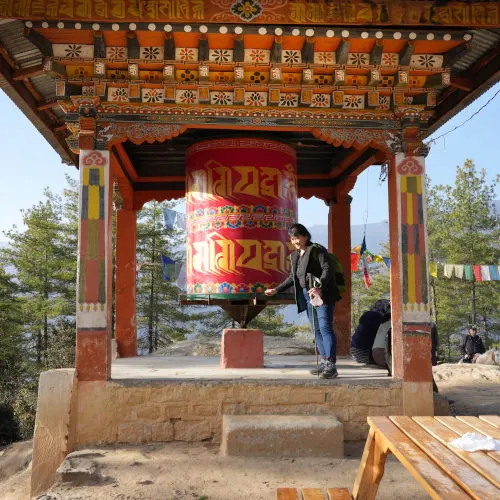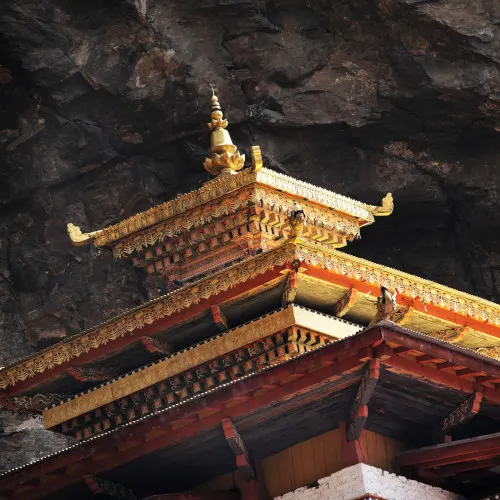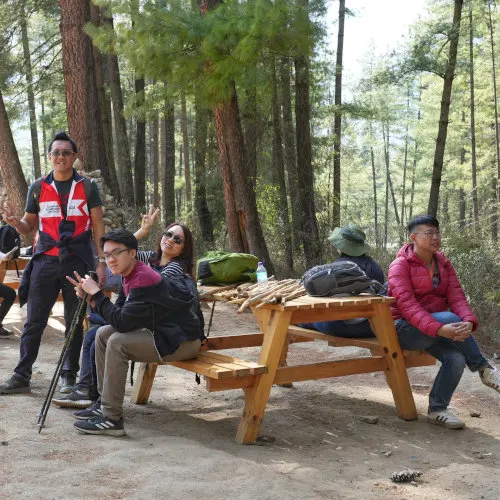We just returned from our Bhutan trip yesterday and can’t wait to write this post about our hiking to the Tiger's Nest Monastery.

We had heard about it so much- a place for the Buddhist to pay a pilgrimage in his lifetime, a temple with mystical legends, an unusual architecture that build in a cave at a remote location, the spectacular view of the surrounding mountain ranges and a site to immerse in the Bhutanese culture and spiritual beliefs.
So here we are with other tourmates, climbing up from the trailhead as early as 7.30 am. That meant we had to wake up before 5.00 am, had our breakfast, and took our tour bus from Le Meridian Hotel, which took about 35 minutes to arrive at the car park of the trailhead.
The monastery can only be reached by foot due to its location. Therefore, the hike begins at the parking lot at the base of the mountain.
Note: This post may contain affiliate links. Please read my privacy policy for more info. I may receive commissions for purchases made through links in this post. As an Amazon Associate, I earn from qualifying purchases.
Hiking to the Tiger's Nest
Our guide provided us with trekking poles and offered to rent a mule or horse ride to go uphill until the midway for those who prefer to avoid hiking the whole trail.

We strongly advise anyone to use the toilet at the starting point of the hike, as the next toilet is available only at the halfway point, inside the café.
The round-trip hike generally takes four to five hours, plus an additional hour for the monastery tour. We had taken medicine for high altitude syndrome just in case, but we still did not want to over-exert ourselves. Therefore, we took six hours of slow trekking plus visiting the temple for the entire round trip.

The first part of the hiking trail to the Tiger's Nest
We decided not to ride the horse for several reasons. First, this is the best training opportunity to prepare ourselves for our Mount Kinabalu hike next month. Besides that, riding on the mule only allows us to ascend halfway.

Besides, the mountainous paths become too steep to carry a person securely after the halfway point. Lastly, it can be just as uncomfortable as climbing up on your own if you're not used to it.
Don't miss the video shot at Tiger's Nest. It is at the end of this article. 👇👇

The hiking trail is quite broad. It is divided into two paths at specific points, one for the mules and one for people to track. It is relatively easy to walk, and there are steps in most sections.

The trail is near the side of a cliff, so you must be careful while walking. However, it also offers the opportunity to view the Paro Valley and the magnificent mountain ranges.


We took about 1.5 hours to complete the ascent to the café, roughly halfway up. We stopped multiple times to take photographs at various locations.




The mule/horse will stop here as the following part of the trek is too steep to carry a person up.


The Taksang Cafeteria at the midpoint

The trail levels off at the midway point. You can do your prayers here and take a rest from your hiking to the Tiger's Nest at the Taktsang Cafeteria.
In addition to indoor seating, where you can purchase snacks and beverages, there are restrooms.
We took a brief break—about 10 to 15 minutes—and took some pictures at the view platform of the cafe.

We didn't want to stop for too long because it was getting hotter outside. Besides, the monastery will not accept guests entering after 11.00 am, so the best time to start hiking to the Tiger's Nest is as early as possible.
We still had another 40 minutes of hiking before we arrived at the Tiger's Nest. So we immediately resumed our journey.
The vegetation also changes into a pine forest.

There are numerous prayer flags along the way. As you ascend, savor the sights of the valley. The view gets better and better.

The final part of the Tiger's Nest trail

A trail after the cafe is more challenging than before. Fewer steps are being constructed, and certain steep trails and rocky sections.

We took about another 45 minutes of tracking to reach Tiger’s Nest monastery from the cafe.

We reached the well-constructed stone steps 20 minutes before arriving at the monastery. There are a few viewpoints where we stopped to admire the stunning views of the Tiger's Nest Monastery.

The final push to the top was a bit challenging with thinner air and rising heartbeats.,

You must walk up a few hundred steps, then descend several hundred to cross the bridge over a small waterfall. After that, there are a few more hundred steps before reaching the entrance.
Visit the Tiger's Nest Monastery

When we arrived at the Tiger's Nest Monastery, we had to leave behind our backpacks, cameras, mobile phones, and shoes. There was security personnel stationed just outside the monastery's gates.

Our guide took us to the main building of the Tiger's Nest Monastery. Unfortunately, we cannot provide images here since photography is strictly prohibited.

Tiger's Nest Monastery is perched at the cliff's edge 3120m above sea level.


We spent about an hour inside the Tiger’s Nest Monastery, visiting the Lhakangs at the main temple and lighting some butter lamps for prayers. The small lamp is 50 ngultrum, and the bigger one is 100 ngultrum each.

After visiting the Buddhist monastery, we took our own pace to descend, which can only be done on foot. (There was no mule service for descending).

The History and legend of Tiger’s Nest Monastery
The Tiger's Nest Monastery, also known as Paro Taktsang Monastery, was built in 1693 by Guru Rinpoche.
According to the Bhutanese legend, Guru Rinpoche (also called Guru Padmasambhava, the second Buddha) meditated in Eastern Bhutan and saw the Tiger Nest in his meditation. He manifested himself in one of his forms as Guru Dorje Drolö. One of his spiritual consorts, Yeshi Tshogyal, transformed herself into a tigress. Gurun Rinpoche rode on the back of the tigress from Singye Dzong in Eastern Bhutan to Taktsang.
During that time, there were local deities and demons as bonism was practiced in Bhutan. So he meditated in the Taktsang Senge Samdup cave at Tiger's Nest for three months and subdued the local spirits and demons, converting them to Buddhism.
That is why Tiger’s Nest is one of the sacred sites in Bhutan. For this reason, it is not only for hiking for the Bhutanese people but a pilgrimage.
Note: The name Takshang means Tiger’s Lair. Tak means Tiger, and Tshang means lair/nest.

A brief history of Paro Taktsang
The temple is said to have been built in the 8th century, in which the chief architect was none other than Guru Padmasambhava.
The present structure was constructed in the late 17th century by the founder of Bhutan, Zhabdrung Rinpoche.
Unfortunately, a major fire set Tiger's Nest Monastery ablaze in 1998 and destroyed most of the wooden structures, intricate carvings, and murals. However, the restoration work was finished in 2005, which is what we visited today.
Booking.comWatch our video shot during our trip to the Tiger's Nest Monastery. 👇👇
If you have read this blog post this far, don't miss out on the video shot during our hike to the Tiger's Nest Monastery. Click the image below to watch on YouTube (shot in high definition!).

The common questions of the Tiger’s Nest hiking
1. What to bring during the hike?
You can bring some snacks and water if you get hungry and thirsty. Also, carrying a walking stick and wearing knee guards is a good idea. It is also advisable to wear comfortable shoes, preferably hiking shoes. Besides that, just enjoy the journey!
2. How long is the round-trip hike?
The Tiger’s Nest trek is about 4 miles (6.4 km), which takes about 4-6 hours to complete for an average person.
3. Will I get high altitude sickness?
Some of us got headaches and palpitations due to the high elevation. Therefore, it is best not to stretch ourselves to the limit. Instead, you can take the high altitude medication called acetazolamide to reduce the chances of getting high altitude syndrome. We took this medication, and we were completely free from any symptoms. Please consult your doctor before your trip.
4. Am I fit enough to hide up to Tiger’s Nest?
It is an easy trail for a seasoned hiker. However, if you are not hiking regularly, you may find difficulties. It is preferred to try hiking before visiting Tiger’s Nest Monastery. We had 82 years old grand lady in our group who managed to hike halfway to the cafe.

Toong Foo Chan
Monday 6th of February 2023
Amazing pictures, lovely blog and big hearts. Definitely one for the bucket list. Much appreciated for sharing.
kwankp
Tuesday 7th of February 2023
Glad to know you like it. We have a few more articles about our Bhutan trip. We hope you like the rest too :)
Esther
Wednesday 1st of February 2023
Just awesome!
Renuka Devi
Wednesday 1st of February 2023
Informative... while reading I could visualize myself walking the trek too. Beautiful scenery. Magnificent structure. Thank you